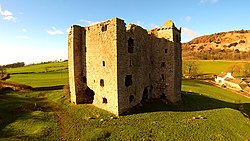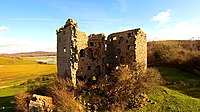Arnside Tower: Difference between revisions
Created page with "{{Infobox castle |name=Arnside Tower |village=Arnside |county=Westmorland |picture=Arnside Tower from the south west - geograph.org.uk - 418663.jpg |picture caption=Arnside To..." |
No edit summary |
||
| Line 1: | Line 1: | ||
{{Infobox castle | {{Infobox castle | ||
|name=Arnside Tower | |name=Arnside Tower | ||
|county=Westmorland | |county=Westmorland | ||
|picture=Arnside Tower | |picture=Arnside Tower, front, Feb 2016.jpg | ||
|picture caption=Arnside Tower | |picture caption=Arnside Tower | ||
|os grid ref=SD457768 | |os grid ref=SD457768 | ||
|latitude=54. | |latitude=54.1841 | ||
|longitude=-2. | |longitude=-2.8335 | ||
|type= | |type=Peel tower | ||
|materials=Limestone rubble | |materials=Limestone rubble | ||
|height= | |height= | ||
|condition=Ruined | |condition=Ruined | ||
|ownership= | |ownership=private | ||
|battles= | |||
|events= | |events= | ||
}} | }} | ||
'''Arnside Tower''' is a late-mediæval tower house or | '''Arnside Tower''' is a late-mediæval tower house (or Pele tower) between [[Arnside]], [[Westmorland]] and [[Silverdale, Lancashire]], standing immediately to the south of [[Arnside Knott]], on the Westmorland side of the county border. | ||
==History== | ==History== | ||
[[File: | [[File:Arnside_Tower,_rear,_Feb_2016.jpg|left|thumb|200px|The tower and its collapsed wall]] | ||
Arnside Tower was built in the second half of the 15th century; | Arnside Tower was built in the second half of the 15th century; one of numerous defensive towers built in what were then the unquiet border counties.<ref>Emery, p.183.</ref> Constructed of limestone rubble, the tower was originally five storeys high, measuring 50 feet by 34 feet.<ref>Emery, p.183; ''[http://www.gatehouse-gazetteer.info/English%20sites/301.html Arnside Tower]'', Gatehouse Gazetteer</ref> The tower was built with an adjacent wing of equal height built onto the side of the tower in a style common in Scotland, but rare in English tower houses.<ref>Pettifer, p.265.</ref> Anthony Emery suggests that the design may have been influenced by that at [[Ashby de la Zouch Castle]], rebuilt in 1464 by Lord Hastings.<ref>Emery, p.184.</ref> | ||
The tower suffered a serious fire in 1602 | The tower suffered a serious fire in 1602, and from 1603 its defensive purpose became redundant as peace was established in what were now to be known as the [[Middle Shires]]. Nevertheless, the tower was repaired after the fire and remained in occupation. Anthony Emery states that the tower was in use until the end of the 17th century, but Roy Palmer states that William Coward and his sister Agnes Wheeler lived there at the end of the 18th century.<ref>Emery, p.184; Roy Palmer, ‘Wheeler , Agnes (bap. 1734, d. 1804)’, Oxford Dictionary of National Biography, Oxford University Press, 2004 [http://www.oxforddnb.com/view/article/45867, accessed 1 June 2017]</ref> | ||
One of the walls of the tower collapsed around 1900, and as of 2014, [[English Heritage]] considered the condition of the castle to be very bad and urgent works are required.<ref>[https://content.historicengland.org.uk/images-books/publications/har-2014-registers/nw-HAR-register-2014.pdf Heritage at Risk Register 2014: North West]: English Heritage, page 36</ref> | |||
One of the walls of the tower collapsed around 1900, and as of | |||
Arnside Tower is a Scheduled Monument and Grade II* listed building.<ref>Heritage at Risk Register 2014, p.36.</ref><ref>{{NHLE|1007142|Arnside Tower}}</ref><ref>{{NHLE|1312275|Arnside Tower}}</ref> | |||
==Tourism== | |||
The tower is in private ownership and is in a ruinous state. The local tourist board recommends that good views of the tower can be made from the public footpath which runs alongside. | |||
[[File:Arnside_tower,_looking_south_west,_2016.jpg|right|thumb|250px|The tower site looking south-west]] | |||
==Outside links== | |||
{{commons}} | |||
*{{youtube|FrDS7wIcE20|Drone video of the tower}} | |||
==References== | ==References== | ||
{{Reflist}} | {{Reflist}} | ||
*Emery, Anthony: '[https://books.google.com/books?id=FJNmewAACAAJ&dq=inauthor:%22Anthony+Emery%22&hl=en&ei=gaSLTcO0EoSHhQe_qIy1Dg&sa=X&oi=book_result&ct=result&resnum=5&ved=0CEIQ6AEwBA Greater Mediæval Houses of England and Wales, 1300-1500: Northern England.]' (Cambridge University Press, 1996) ISBN 978-0-521-49723-7 | |||
*Emery, Anthony | *Pettifer, Adrian: '[https://books.google.com/books?id=47iheRUGKIEC&printsec=frontcover&source=gbs_ge_summary_r&cad=0#v=onepage&q&f=false English Castles: a Guide by Counties]' (Boydell Press, 2004) ISBN 978-0-85115-782-5 | ||
*Pettifer, Adrian | |||
Latest revision as of 17:50, 7 September 2017
| Arnside Tower | |
|
Westmorland | |
|---|---|
 Arnside Tower | |
| Type: | Peel tower |
| Location | |
| Grid reference: | SD457768 |
| Location: | 54°11’3"N, 2°50’1"W |
| History | |
| Information | |
| Condition: | Ruined |
| Owned by: | private |
Arnside Tower is a late-mediæval tower house (or Pele tower) between Arnside, Westmorland and Silverdale, Lancashire, standing immediately to the south of Arnside Knott, on the Westmorland side of the county border.
History

Arnside Tower was built in the second half of the 15th century; one of numerous defensive towers built in what were then the unquiet border counties.[1] Constructed of limestone rubble, the tower was originally five storeys high, measuring 50 feet by 34 feet.[2] The tower was built with an adjacent wing of equal height built onto the side of the tower in a style common in Scotland, but rare in English tower houses.[3] Anthony Emery suggests that the design may have been influenced by that at Ashby de la Zouch Castle, rebuilt in 1464 by Lord Hastings.[4]
The tower suffered a serious fire in 1602, and from 1603 its defensive purpose became redundant as peace was established in what were now to be known as the Middle Shires. Nevertheless, the tower was repaired after the fire and remained in occupation. Anthony Emery states that the tower was in use until the end of the 17th century, but Roy Palmer states that William Coward and his sister Agnes Wheeler lived there at the end of the 18th century.[5]
One of the walls of the tower collapsed around 1900, and as of 2014, English Heritage considered the condition of the castle to be very bad and urgent works are required.[6]
Arnside Tower is a Scheduled Monument and Grade II* listed building.[7][8][9]
Tourism
The tower is in private ownership and is in a ruinous state. The local tourist board recommends that good views of the tower can be made from the public footpath which runs alongside.

Outside links
| ("Wikimedia Commons" has material about Arnside Tower) |
- Drone video of the tower - YouTube
References
- ↑ Emery, p.183.
- ↑ Emery, p.183; Arnside Tower, Gatehouse Gazetteer
- ↑ Pettifer, p.265.
- ↑ Emery, p.184.
- ↑ Emery, p.184; Roy Palmer, ‘Wheeler , Agnes (bap. 1734, d. 1804)’, Oxford Dictionary of National Biography, Oxford University Press, 2004 accessed 1 June 2017
- ↑ Heritage at Risk Register 2014: North West: English Heritage, page 36
- ↑ Heritage at Risk Register 2014, p.36.
- ↑ National Heritage List 1007142: Arnside Tower
- ↑ National Heritage List 1312275: Arnside Tower
- Emery, Anthony: 'Greater Mediæval Houses of England and Wales, 1300-1500: Northern England.' (Cambridge University Press, 1996) ISBN 978-0-521-49723-7
- Pettifer, Adrian: 'English Castles: a Guide by Counties' (Boydell Press, 2004) ISBN 978-0-85115-782-5
